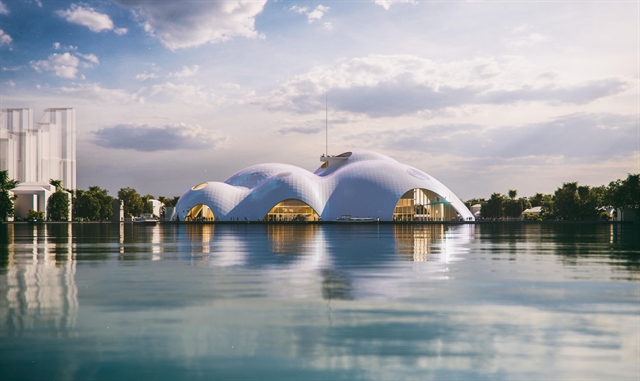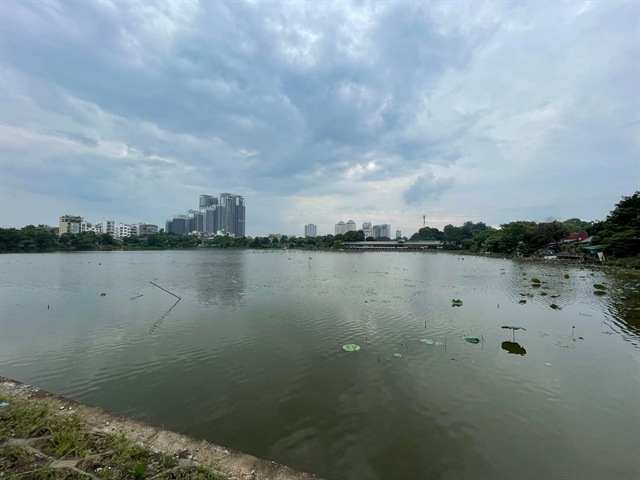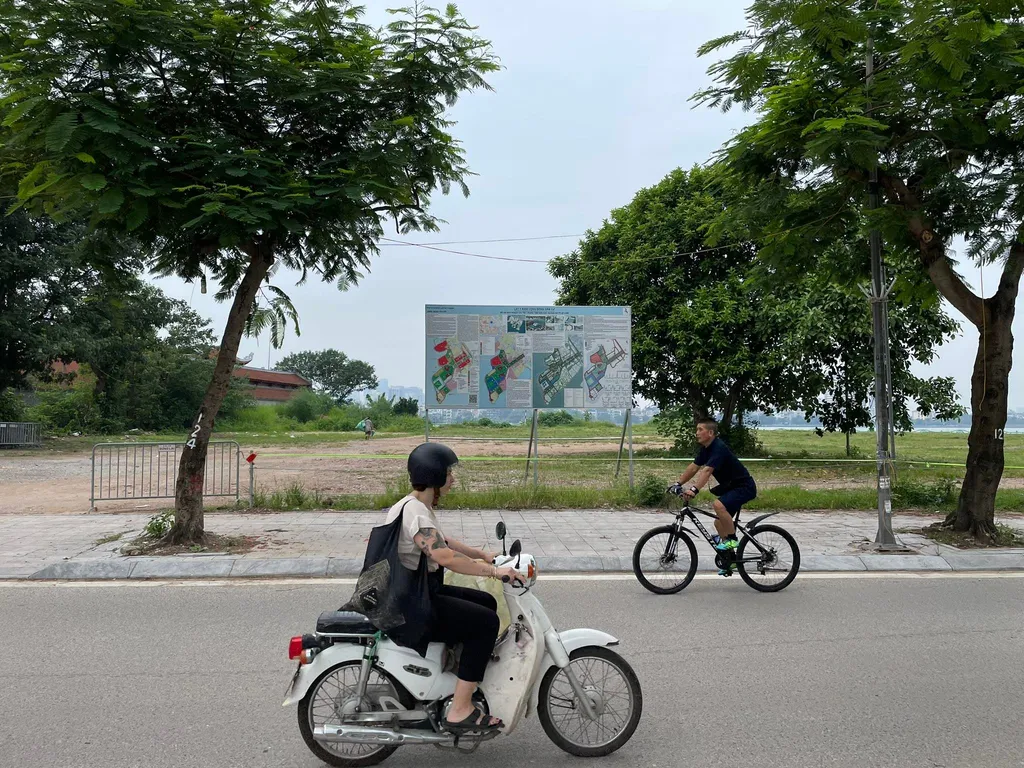 Opinion
Opinion

 |
| An artist's impression of the Opera House project on West Lake, as designed by Italian architect Renzo Piano. Photo from Renzo Piano Building Workshop: RPBW Architects |
Hà Nội is collecting people’s feedback on the detailed planning of Quảng An Peninsula in West Lake, which includes the controversial proposal of a floating opera house. Phan Đăng Sơn, chair of the Vietnamese Architects’ Association, talks to local media about the legality and other factors that need to be considered in the planning.
What is your assessment of the detailed planning of the Quảng An and the proposed opera house project?
First of all, in term of legality, Hà Nội’s construction planning has been approved by the Prime Minister seven times since the founding of the country in 1945, then in 1961, 1974, 1976, 1981, 1992, 1998, and more recently in 2011.
Starting from the approved planning in 1992, it was clearly stated that the West Lake area is the centre of Hà Nội with the general criteria: "The West Lake area must be planned and built into a centre of international trading, tourism services, culture and sports, and a natural landscape protection area serving the capital city’s entertainment activities."
In 1994, the Government authorised the Minister of Construction to assess and approve construction planning in some key areas of Hà Nội, and the ministry approved one that included an ‘axis’ of twin roads about 700m long in the Quảng An Peninsula, as what is seen in the version for which feedback is being sought from the local residents. The difference is that at the end of these twin roads, instead of a system of internal lakes about 60ha, has been paved over for quite some time leaving only a small lake for growing lotus that is no longer connected to West Lake.
In 1998, it was noted that in this area, there should be national-level services, culture, and commerce buildings. In 2008, when Hà Nội incorporated the former province Hà Tây, another plan was submitted to the Government for approval, in which the part about the West Lake essentially remains the same as before, stressing “the building of the capital city’s exemplary cultural buildings such as museums and theatres, etc. associated with its natural landscapes such as the Red River, the West Lake, Cổ Loa, Thăng Long Imperial Citadel, etc.”
So, it could be said that since 1992, the planning for the Quảng An Peninsula has been quite consistent, and Hà Nội has the legality to implement detailed planning of this area.
Regarding the opera house project over the Đầm Trị, from the 2010s, the city’s authorities have sought to build a big, modern, multifunctional theatre in the western area of West Lake. In 2017, the proposed opera house was ‘relocated’ to the new district Nam Từ Liêm, but both times, the plan didn’t go anywhere due to many reasons.
 |
| Đầm Trị Lake, where the proposed Opera House is to be built. — VNS Photo Seán Nolan |
Can you tell us your opinion on the opera house’s currently proposed location and its influence?
The architect association sees that there is currently not one architectural highlight of cultural and tourism significance as expected in the West Lake area, and this is something that needs to be addressed.
The location of the project at Đầm Trị Lake, which is the ‘central’ area and the endpoint of the peninsula’s spatial axis connecting it to the West Lake, is reasonable, making it visible from multiple angles.
Regarding the design, the visual of mother-of-pearl emerging from the waters is a unique creation rich in historical and cultural values that is still suitable with the tranquil atmosphere of West Lake.
The mastermind of this design is the Italian architect, Renzo Piano, a legendary architect. According to the design concept, the opera house is like an "Island of Music" over West Lake. Renzo Piano is also one of the world's leading contemporary architects in designing works of this nature. He won the opera house design competition in Hà Nội more than 12 years ago. In addition, the design plan offers diverse functions, suitable for modern and future use requirements, meeting the demands for creative design that is in harmony with the surrounding space.
The shape is soft, gentle, and it is integrating well into the surrounding environment, similar to famous theatres in Beijing, Sydney, Dubai, and Singapore. With the participation of world-famous architects, there will be great opportunities for regional cultural development, and the site will certainly attract a large number of international visitors.
The implementation of this project has the consultation and participation of the world’s leading experts, with serious professionalism and labour.
If Hà Nội chooses to go ahead with the opera house model, this one will be a certified global attraction, with its highly artistic values. This opera house, in my opinion, can hold its own against other famous theatres around the world.
 |
| The planned development for Quảng An peninsula on a billboard opposite Đầm Trị Lake. The road separating Đầm Trị and West Lake is a busy thoroughfare. — VNS Photo Seán Nolan |
{ "id": "yev1pSfDIH", "type": "myToolImages", "data": { "data": "" } }
What do you think are the other issues that the planning of Quảng An Peninsula and the building of the opera house would need to be addressed?
With regards to traffic route, access to the opera house must be suitable for vehicles, especially within walking distance. It has also been suggested that an underwater walkway from the park under the lake to the opera house, like in the case of the Beijing Opera House, be constructed.
In addition, attention should be paid to the harmonious connection of the region's cultural and spiritual elements with the requirements of quiet landscape. We also need thorough research to have convincing evidence on the contribution of the opera house’s architectural design to the special cultural space that is the West Lake region.
With regards to the objections to the planning and construction of this opera house, we think that among them there are opinions with enthusiasm, thorough analysis, and rich expertise, that the city’s authorities should gather, study and review to make appropriate, reasonable adjustments.
The implementation of the approved planning in accordance with the law and consistency is necessary because this is an extremely important project, with its large scale and sensitive location in a special cultural area, so it is recommended that the city organise more seminars to listen to and consult experts and the local community, and if possible, seek feedback from all the capital city’s residents with regards to the opera house model.
Hà Nội has experienced two ‘misses’ with this opera house project. What does the capital city need to do to soon implement the planning, and have more cultural buildings serving the community?
This is an issue that needs serious consultation from many parties. In the past, when planning for the Quảng An Peninsula, we have mobilised professional expertise from multiple generations in a methodical and sufficient manner, and the planning can be considered to be of high quality.
The planning is legally approved by the Government and Prime Minister, so compliance with the law is not a question.
Some people say that this is not time to build a project like an opera house, but that focus should be more on practical works such as roads and housing. But, it must be recognised that culture is no less important than material products such as roads and houses. The Communist Party of Việt Nam has also stressed that culture must be considered to be on the same level of importance as politics and society, and culture should be the driving force for development. At present, it is necessary to carry out focal services and cultural industries.
Hà Nội has a profound historical and cultural tapestry and rich potential for the development of cultural products, but the implementation has not been satisfactory. Therefore, implementing the construction of the opera house, I think, is an urgent task, not just “a right time” issue even. The construction might take five years to complete and people’s cultural needs and demands could definitely have grown significantly by then.
It should be emphasised that in the last 40 years, Hà Nội City has not had a cultural work of a large enough scale to compare with other countries in the region. I think there should be a building that can make Hà Nội live up to its position as the cultural and political centre of the country. — VNS
{ "id": "OTmoMJsoJ9", "type": "myToolSearch", "data": { "data": "" } }
| The opera house, covering around 13,000sq.m., would include an auditorium of 1,822 seats, and could also host large-scale cultural and arts events in other multi-purpose auditoriums with 1,000-2,000 seats. Also planned for the inside of the theatre is a series of function rooms, such as an art practice room and a library on the ground floor. A museum and a small restaurant with panoramic views of West Lake would be on the higher floors. Outside the building, public spaces would include exhibition halls and food courts stretching along the main traffic axis and ending at the central square near the lake's edge. |




